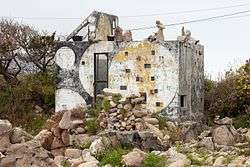Manfred Gnädinger



Manfred Gnädinger (Dresden 1940 – Camelle, 28 December 2002) a.k.a. Man or O Alemán was a German hermit and sculptor who lived in the village of Camelle, on the Costa da Morte, in Galicia (Spain). He lived a very simple and natural life, building sculptures on the beach where he lived and tending to his small garden. In November 2002, when the oil spill of the Prestige destroyed his sculptures and the ecosystem of the area he lived in, it is thought that Man let himself die of melancholy and sadness, thus becoming a symbol of the destruction unleashed by the oil spill.[1][2]
Hermit and sculptor
Man arrived in the small village of Camelle in 1962, from Boehringen in the south of Germany. His whereabouts before this period are unknown, although he was described as having been well-dressed and educated when he arrived. It is said that he went mad after falling in love with the teacher of the village and being refused. A few years later, after becoming sensitized to ecological issues, he built himself a small hut on the beach of the village, next to the Atlantic Ocean, and spent the next forty years in this place, where he quickly became a curiosity of the village. Inhabitants referred to him in Galician as O Alemán (the German), then just "Man", a name he eagerly accepted for its symbolism. Tall, with a long beard, and dressed only with a loincloth in any weather, he would swim out in the Ocean, even after he was fifty years old. He had no electricity or running water in his hut, and was a strict vegetarian, eating only from the small organic garden he had created.[3]
Man executed colorful sculptures out of stones, driftwood, animal remains and other elements washed up by the sea, which sometimes reminded people of Gaudí's work. Tourists would come to visit the open-air museum he had created where the sculptures integrated into the natural landscape. Man's only source of revenue was a small fee (1€ as of 2002) he would ask from everyone visiting the Museum of the German. Man would also ask visitors to do drawings for him in small notebooks. Dozens of such notebooks were found after his death with hundreds of drawings.[4]
The Prestige
On 17 November 2002, the oil tanker Prestige split in half and sank in the Atlantic Ocean, after having had a huge leak in its tanks. A few days later, Man woke up to find his life ruined by an oil spill. Tons of oil had washed up on the beach where he lived. Most of his sculptures were irremediably destroyed and the oil even reached his house. Man was absolutely devastated, his whole life work destroyed before his eyes, and the natural environment where he lived heavily polluted for years to come. A month later, he was found dead in his hut. He had circulatory and respiratory problems, but most local people believe that he died of melancholy and sadness at the sight of the complete and utter destruction of his life by the oil spill. The Camelle authorities organized and paid for his funeral, and hundreds of locals attended.[1]
Thousands of birds and fish died in the aftermath of the oil spill, but Man was the only human victim. His life and his death are remembered as a symbol of the destruction unleashed by the Prestige. His museum, which he donated to the city before his death, could still be visited in Camelle[5] until 9 November 2010, when the remains of his legacy were destroyed by a strong gale.[6]
At the 10th date of death Manfred Gnadinger was disinterred and cremated to be buried in his museum. This was one of his last wishes in the testament. Since then the urn with his ashes is still not buried.
References
- 1 2 "Hermit sculptor 'killed by oil spill'" - BBC News
- ↑ "L'HOMME QUI EST MORT DE CHAGRIN" - France 5
- ↑ "Os segredos de Man" - Xornal.com
- ↑ "Man, o alemán de Camelle, xa ten fundación" - Xornal.com
- ↑ "El legado de Man de Camelle sigue en el olvido siete años después de muerto" - La Opinión A Coruña
- ↑ "El temporal arrasa el patrimonio olvidado de Man" - La Voz de Galicia
Bibliography
- A pegada de Man, text and photos by Xoán Abeleira, Xerais, Vigo (Galicia), 2006. This is the first book published of Manfred Gnädinger.
- Cequera, Bernardo: Manfred, the German of Camelle. Film Documentary 60 min. (2008)
External links
| Wikimedia Commons has media related to Manfred Gnädinger. |